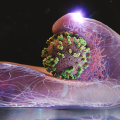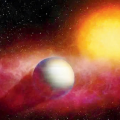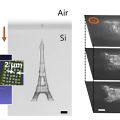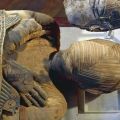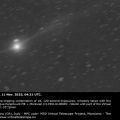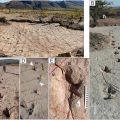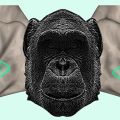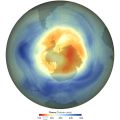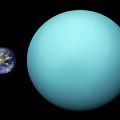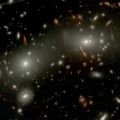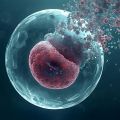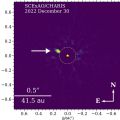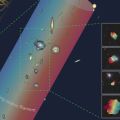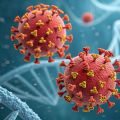Origine africaine de l'homme moderne - Définition
La liste des auteurs de cet article est disponible ici.
Expansion
Il y a 50 000 ans, ces populations se répandent du Proche-Orient vers l'est et l'Asie du Sud. Il y a 40 000 ans, d'autres poursuivent vers l'Australie où pour la première fois, Homo sapiens colonise un territoire où Homo erectus n'a jamais vécu. Cro-Magnon arrive en Europe il y a également quelque 40 000 ans. L'Asie de l'Est (Corée et Japon) est atteinte il y a 30 000 ans. On débat encore pour savoir si le premier peuplement de l'Amérique qui s'ensuit s'est déroulés il y a 30 000 ans, ou beaucoup plus tard, il y a environ 14 000 ans.
The group that crossed the Red Sea travelled along the coastal route around the coast of Arabia and Persia until reaching India, which appears to be the first major settling point. M is found in high frequencies along the southern coastal regions of Pakistan and India and it has the greatest diversity in India, indicating that it is here where the mutation may have occurred. 60% of the Indian population belong to Haplogroup M. The indigenous people of the Andaman Islands also belong to the M lineage. The Andamanese are thought to be offshoots of some of the earliest inhabitants in Asia because of their long isolation from mainland Asia. They are evidence of the coastal route of early settlers that extends from India along the coasts of Thailand and Indonesia all the way to Papua New Guinea. Since M is found in high frequencies in highlanders from New Guinea as well, and both the Andamanese and New Guineans have dark skin and Afro-textured hair, some scientists believe they are all part of the same wave of migrants who departed across the Red Sea ~60,000 years ago in the Great Coastal Migration. Notably, the findings of Harding et al.(2000, p 1355) show that, at least with regard to dark skin color, the haplotype background of Papua New Guineans at MC1R (one of a number of genes involved in melanin production) is identical to that of Africans (barring a single silent mutation). Thus, although these groups are distinct from Africans at other loci (due to drift, bottlenecks, etc), it is evident that selection for the dark skin color trait likely continued (at least at MC1R) following the exodus. This would support the hypothesis that suggests that the original migrants from Africa resembled pre-exodus Africans (at least in skin color), and that the present day remnants of this ancient phenotype can be seen among contemporary Africans, Andamanese and New Guineans. Others suggest that their physical resemblance to Africans could be the result of convergent evolution..
From Arabia to India the proportion of haplogroup M increases eastwards: in eastern India, M outnumbers N by a ratio of 3:1. However, crossing over into East Asia, Haplogroup N reappears as the dominant lineage. M is predominant in South East Asia but amongst Indigenous Australians N reemerges as the more common lineage. This discontinuous distribution of Haplogroup N from Europe to Australia can be explained by founder effects and population bottlenecks.
Exode d'Afrique

Il y a quelque 70 000 ans, une partie des porteurs de l'haplogroupe mitochondrial L3 ont migré d'Afrique orientale au Proche-Orient.
Some scientists believe that only a few people left Africa in a single migration that went on to populate the rest of the world. It has been estimated that from a population of 2,000 to 5,000 in Africa, only a small group of possibly 150 people crossed the Red Sea. This is because, of all the lineages present in Africa, only the daughters of one lineage, L3, are found outside Africa. Had there been several migrations one would expect more than one African lineage outside Africa. L3's daughters, the M and N lineages, are found in very low frequencies in Africa (although haplogroup M1 is very ancient and diversified in North and Northeast Africa) and appear to be recent arrivals. A possible explanation is that these mutations occurred in East Africa shortly before the exodus and by the founder effect became the dominant haplogroups after the exodus from Africa. Alternatively, the mutations may have arisen shortly after the exodus from Africa.
Other scientists have proposed a Multiple Dispersal Model, in which there were two migrations out of Africa, one across the Red Sea travelling along the coastal regions to India (the Coastal Route), which would be represented by Haplogroup M. Another group of migrants with Haplogroup N followed the Nile from East Africa, heading northwards and crossing into Asia through the Sinai. This group then branched in several directions, some moving into Europe and others heading east into Asia. This hypothesis attempts to explain why Haplogroup N is predominant in Europe and why Haplogroup M is absent in Europe. Evidence of the coastal migration is hypothesized to have been destroyed by the rise in sea levels during the Holocene epoch. Alternatively, a small European founder population that initially expressed both Haplogroup M and N could have lost Haplogroup M through random genetic drift resulting from a bottleneck (i.e. a founder effect).
Aujourd'hui le détroit de Bab-el-Mandeb dans la mer Rouge fait environ 20 kilomètres de largeur. Mais il y a 50 000 ans, lorsque le niveau de la mer était 70 mètres plus bas qu'aujourd'hui, il était beaucoup plus étroit. Though the straits were never completely closed, there may have been islands in between which could be reached using simple rafts. Shell middens 125,000 years old have been found in Eritreawas there charcoal, lemons?[citation nécessaire] indicating the diet of early humans included seafood obtained by beachcombing.








